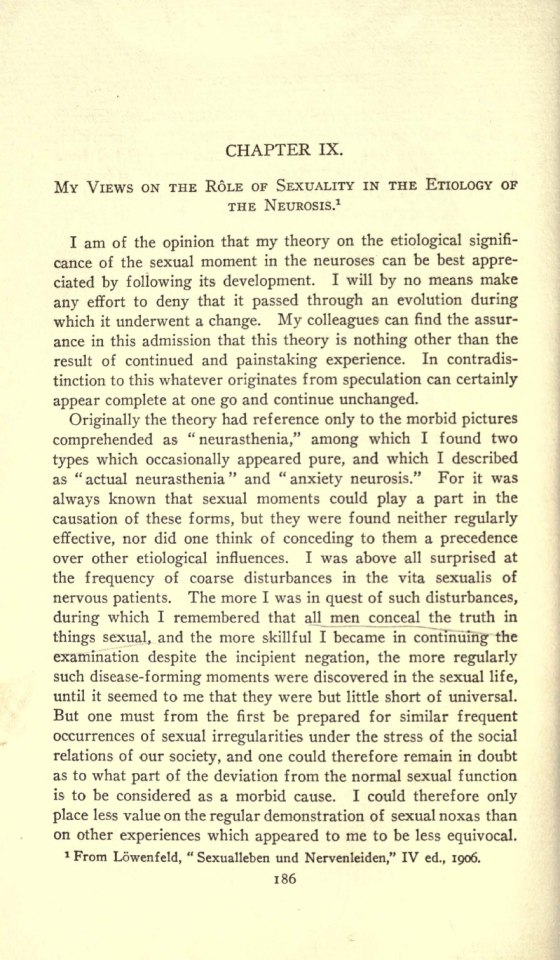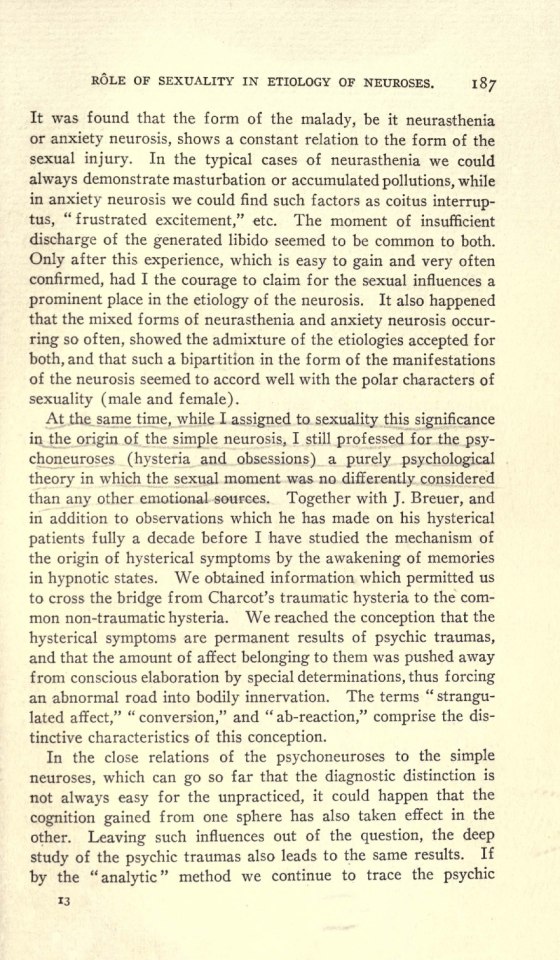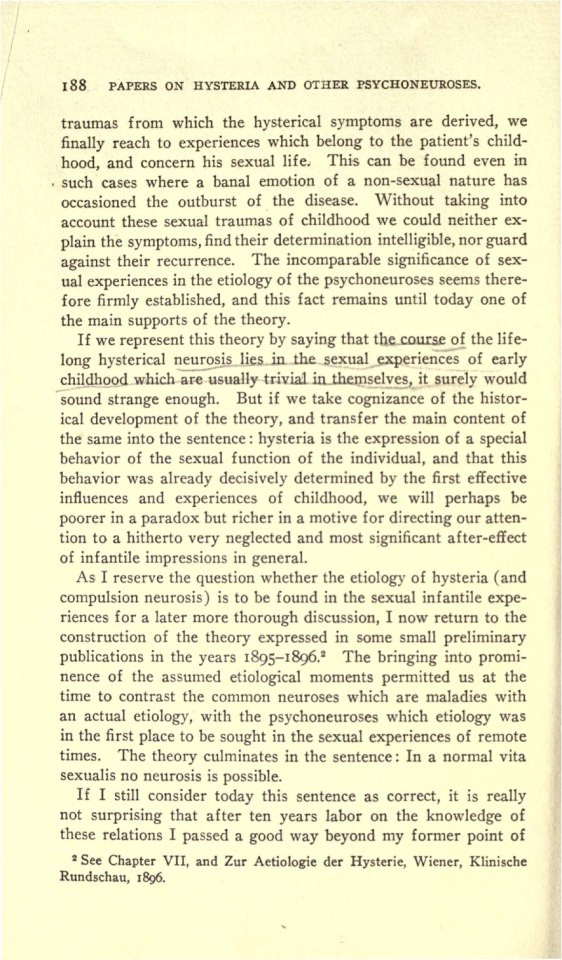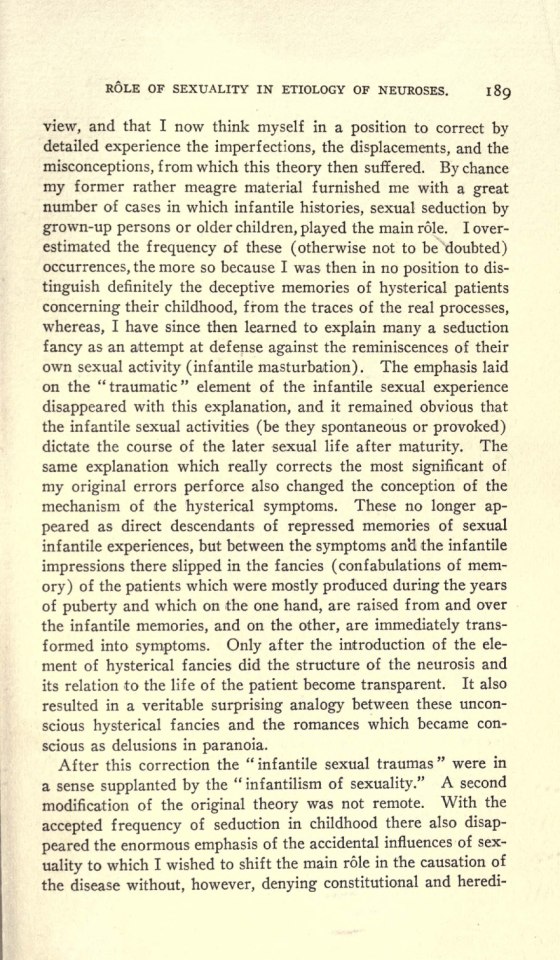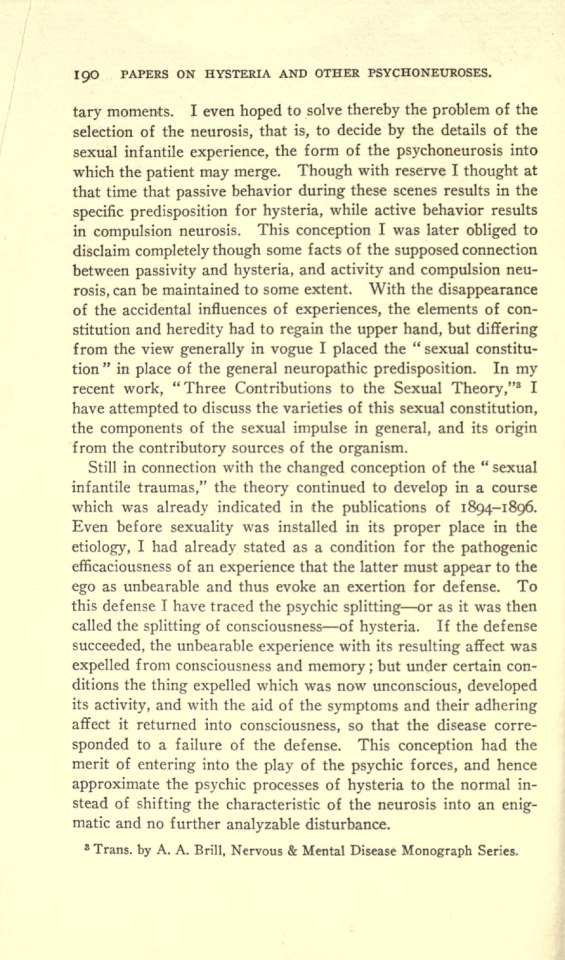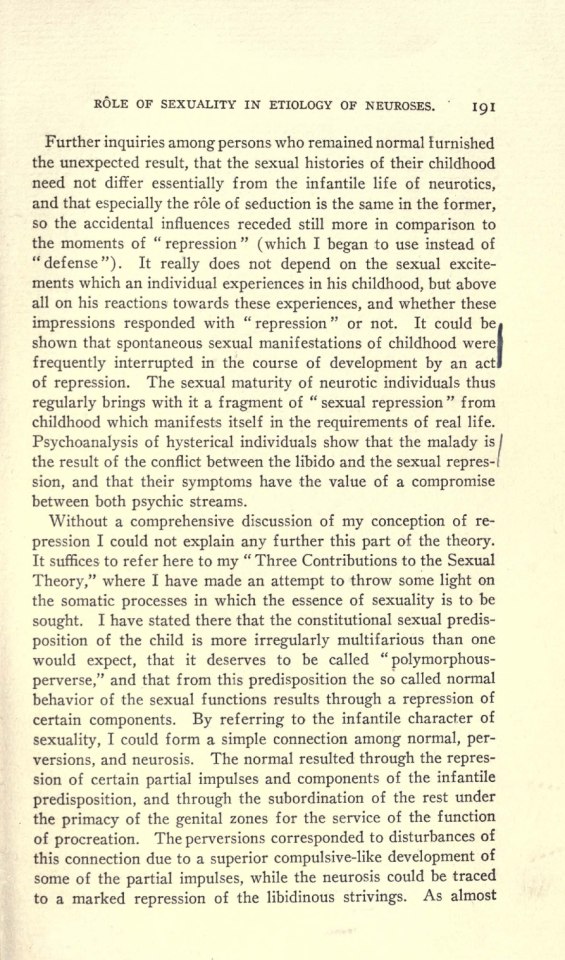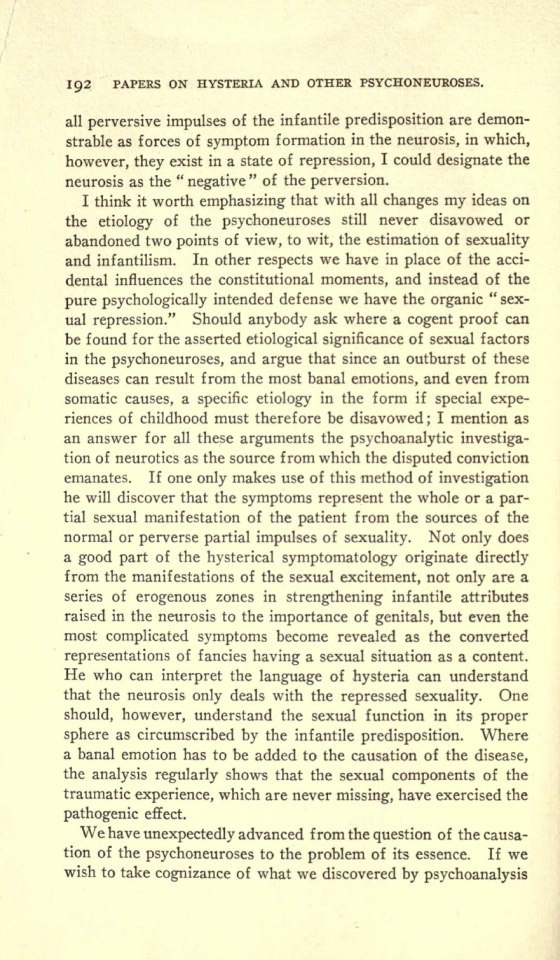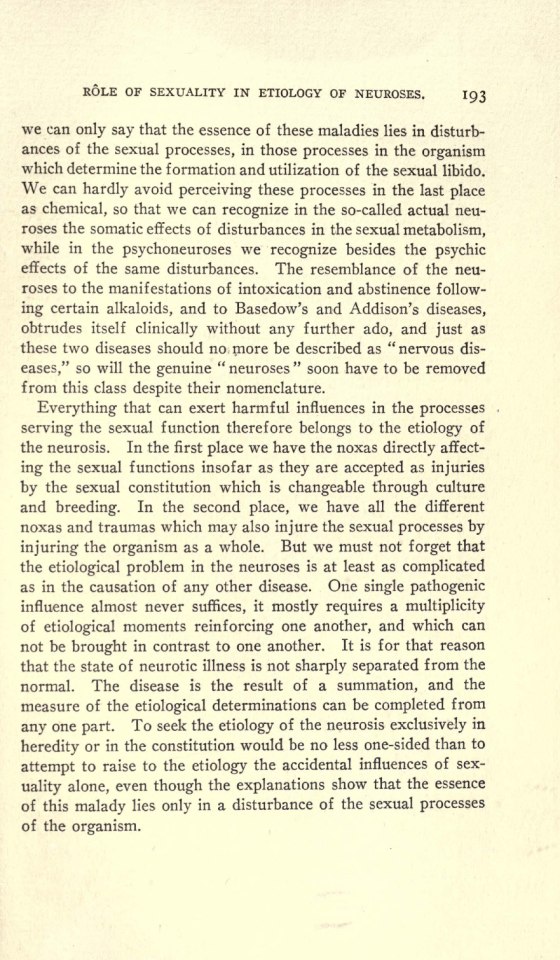S.
CHAPTER IX.
My VIEWS ON THE ROLE עס SEXUALITY IN THE ETIOLOGY OF
THE NEUROSIS.I am of the opinion that my theory on the etiological signifi-
cance of the sexual moment in the neuroses can be best appre-
ciated by following its development. I will by no means make
any effort to deny that it passed through an evolution during
which it underwent a change. My colleagues can find the assur-
ance in this admission that this theory is nothing other than the
result of continued and painstaking experience. In contradis-
tinction to this whatever originates from speculation can certainly
appear complete at one go and continue unchanged.Originally the theory had reference only to the morbid pictures
comprehended as “neurasthenia among which I found two
types which occasionally appeared pure, and which I describeds “actual neurasthenia “ and “anxiety neurosis.” For it was
always known that sexual moments could play a part in the
causation of these forms, but they were found neither regularly
effective, nor did one think of conceding to them a precedence
over other etiological influences. I was above all surprised at
the frequency of coarse disturbances in the vita sexualis of
nervous patients. The more I was in quest of such disturbances,
during which I remembered that all men conceal the truth in
things sexual, and the more skillful I became in continuing the
examination despite the incipient negation, the more regularly
such disease-forming moments were discovered in the sexual life,
until it seemed to me that they were but little short of universal.
But one must from the first be prepared for similar frequent
occurrences of sexual irregularities under the stress of the social
relations of our society, and one could therefore remain in doubt
as to what part of the deviation from the normal sexual function
is to be considered as a morbid cause. I could therefore only
place less value on the regular demonstration of sexual noxas than
on other experiences which appeared to me to be less equivocal.1 From Lówenfeld, “ Sexualleben und Nervenleiden,” IV ed., 1906.
186
S.
ROLE OF SEXUALITY IN ETIOLOGY OF NEUROSES, 187
It was found that the form of the malady, be it neurasthenia
or anxiety neurosis, shows a constant relation to the form of the
sexual injury. In the typical cases of neurasthenia we could
always demonstrate masturbation or accumulated pollutions, while
in anxiety neurosis we could find such factors as coitus interrup-
tus, “frustrated excitement,” etc. The moment of insufficient
discharge of the generated libido seemed to be common to both.
Only after this experience, which is easy to gain and very often
confirmed, had I the courage to claim for the sexual influences a
prominent place in the etiology of the neurosis. It also happened
that the mixed forms of neurasthenia and anxiety neurosis occur-
ring so often, showed the admixture of the etiologies accepted for
both, and that such a bipartition in the form of the manifestations
of the neurosis seemed to accord well with the polar characters of
sexuality (male and female).At the same time, while I assigned to sexuality this significance
in the origin of the simple neurosis, I still professed for the psy-
choneuroses (hysteria and obsessions) a purely psychological
theory in which the sexual moment was no differently considered
than any other emotional sources. Together with J. Breuer, and
in addition to observations which he has made on his hysterical
patients fully a decade before I have studied the mechanism of
the origin of hysterical symptoms by the awakening of memories
in hypnotic states. We obtained information which permitted us
to cross the bridge from Charcot’s traumatic hysteria to the com-
mon non-traumatic hysteria. We reached the conception that the
hysterical symptoms are permanent results of psychic traumas,
and that the amount of affect belonging to them was pushed away
from conscious elaboration by special determinations, thus forcing
an abnormal road into bodily innervation. The terms “ strangu-
lated affect,” “ conversion,” and “ ab-reaction,” comprise the dis-
tinctive characteristics of this conception.In the close relations of the psychoneuroses to the simple
neuroses, which can go so far that the diagnostic distinction is
not always easy for the unpracticed, it could happen that the
cognition gained from one sphere has also taken effect in the
other. Leaving such influences out of the question, the deep
study of the psychic traumas also leads to the same results. If
by the “analytic” method we continue to trace the psychic13
S.
188 PAPERS ON HYSTERIA AND OTHER PSYCHONEUROSES,
traumas from which the hysterical symptoms are derived, we
finally reach to experiences which belong to the patient's child-
hood, and concern his sexual life. This can be found even in
. such cases where a banal emotion of a non-sexual nature has
occasioned the outburst of the disease. Without taking into
account these sexual traumas of childhood we could neither ex-
plain the symptoms, find their determination intelligible, nor guard
against their recurrence. The incomparable significance of sex-
ual experiences in the etiology of the psychoneuroses seems there-
fore firmly established, and this fact remains until today one of
the main supports of the theory.If we represent this theory by saying that the course of the life-
long hysterical neurosis lies in the sexual experiences of early
childhood which are usually trivial in themselves, it surely would
sound strange enough. But if we take cognizance of the histor-
ical development of the theory, and transfer the main content of
the same into the sentence: hysteria is the expression of a special
behavior of the sexual function of the individual, and that this
behavior was already decisively determined by the first effective
influences and experiences of childhood, we will perhaps be
poorer in a paradox but richer in a motive for directing our atten-
tion to a hitherto very neglected and most significant after-effect
of infantile impressions in general.As I reserve the question whether the etiology of hysteria (and
compulsion neurosis) is to be found in the sexual infantile expe-
riences for a later more thorough discussion, I now return to the
construction of the theory expressed in some small preliminary
publications in the years 1895-1896. The bringing into promi-
nence of the assumed etiological moments permitted us at the
time to contrast the common neuroses which are maladies with
an actual etiology, with the psychoneuroses which etiology was
in the first place to be sought in the sexual experiences of remote
times. The theory culminates in the sentence: In a normal vita
sexualis no neurosis is possible.If I still consider today this sentence as correct, it is really
not surprising that after ten years labor on the knowledge of
these relations I passed a good way beyond my former point of2 See Chapter VII, and Zur Aetiologie der Hysterie, Wiener, Klinische
Rundschau, 1896.S.
ROLE OF SEXUALITY IN ETIOLOGY OF NEUROSES. 189
view, and that I now think myself in a position to correct by
detailed experience the imperfections, the displacements, and the
misconceptions, from which this theory then suffered. By chance
my former rather meagre material furnished me with a great
number of cases in which infantile histories, sexual seduction by
grown-up persons or older children, played the main role. Iover-
estimated the frequency of these (otherwise not to be doubted)
occurrences, the more so because I was then in no position to dis-
tinguish definitely the deceptive memories of hysterical patients
concerning their childhood, from the traces of the real processes,
whereas, I have since then learned to explain many a seduction
fancy as an attempt at defense against the reminiscences of their
own sexual activity (infantile masturbation). The emphasis laid
on the “traumatic” element of the infantile sexual experience
disappeared with this explanation, and it remained obvious that
the infantile sexual activities (be they spontaneous or provoked)
dictate the course of the later sexual life after maturity. The
same explanation which really corrects the most significant of
my original errors perforce also changed the conception of the
mechanism of the hysterical symptoms. These no longer ap-
peared as direct descendants of repressed memories of sexual
infantile experiences, but between the symptoms and the infantile
impressions there slipped in the fancies (confabulations of mem-
ory) of the patients which were mostly produced during the years
of puberty and which on the one hand, are raised from and over
the infantile memories, and on the other, are immediately trans-
formed into symptoms. Only after the introduction of the ele-
ment of hysterical fancies did the structure of the neurosis and
its relation to the life of the patient become transparent. It also
resulted in a veritable surprising analogy between these uncon-
scious hysterical fancies and the romances which became con-
scious as delusions in paranoia.After this correction the “infantile sexual traumas” were in
a sense supplanted by the “infantilism of sexuality.” A second
modification of the original theory was not remote. With the
accepted frequency of seduction in childhood there also disap-
peared the enormous emphasis of the accidental influences of sex-
uality to which I wished to shift the main rôle in the causation of
the disease without, however, denying constitutional and heredi-S.
IQO PAPERS ON HYSTERIA AND OTHER PSYCHONEUROSES.
tary moments. I even hoped to solve thereby the problem of the
selection of the neurosis, that is, to decide by the details of the
sexual infantile experience, the form of the psychoneurosis into
which the patient may merge. Though with reserve I thought at
that time that passive behavior during these scenes results in the
specific predisposition for hysteria, while active behavior results
in compulsion neurosis. This conception I was later obliged to
disclaim completely though some facts of the supposed connection
between passivity and hysteria, and activity and compulsion neu-
rosis, can be maintained to some extent. With the disappearance
of the accidental influences of experiences, the elements of con-
stitution and heredity had to regain the upper hand, but differing
from the view generally in vogue I placed the “sexual constitu-
tion” in place of the general neuropathic predisposition. In my
recent work, “Three Contributions to the Sexual Theory,” I
have attempted to discuss the varieties of this sexual constitution,
the components of the sexual impulse in general, and its origin
from the contributory sources of the organism.Still in connection with the changed conception of the “ sexual
infantile traumas,” the theory continued to develop in a course
which was already indicated in the publications of 1894-1896.
Even before sexuality was installed in its proper place in the
etiology, I had already stated as a condition for the pathogenic
efficaciousness of an experience that the latter must appear to the
ego as unbearable and thus evoke an exertion for defense. To
this defense I have traced the psychic splitting—or as it was then
called the splitting of consciousness—of hysteria. If the defense
succeeded, the unbearable experience with its resulting affect was
expelled from consciousness and memory ; but under certain con-
ditions the thing expelled which was now unconscious, developed
its activity, and with the aid of the symptoms and their adhering
affect it returned into consciousness, so that the disease corre-
sponded to a failure of the defense. This conception had the
merit of entering into the play of the psychic forces, and hence
approximate the psychic processes of hysteria to the normal in-
stead of shifting the characteristic of the neurosis into an enig-
matic and no further analyzable disturbance.8 Trans. by A. A. Brill, Nervous & Mental Disease Monograph Series.
S.
ROLE OF SEXUALITY IN ETIOLOGY OF NEUROSES. ' 191
Further inquiries among persons who remained normal Furnished
the unexpected result, that the sexual histories of their childhood
need not differ essentially from the infantile life of neurotics,
and that especially the role of seduction is the same in the former,
so the accidental influences receded still more in comparison to
the moments of “repression” (which I began to use instead of
f defense”). It really does not depend on the sexual excite-
ments which an individual experiences in his childhood, but above
all on his reactions towards these experiences, and whether these
impressions responded with “repression” or not. It could be
shown that spontaneous sexual manifestations of childhood ver
frequently interrupted in the course of development by an act
of repression. The sexual maturity of neurotic individuals thus
regularly brings with it a fragment of “sexual repression” from
childhood which manifests itself in the requirements of real life.
Psychoanalysis of hysterical individuals show that the malady is |
the result of the conflict between the libido and the sexual repres-
sion, and that their symptoms have the value of a compromise
between both psychic streams.Without a comprehensive discussion of my conception of re-
pression I could not explain any further this part of the theory.
It suffices to refer here to my “ Three Contributions to the Sexual
Theory,” where I have made an attempt to throw some light on
the somatic processes in which the essence of sexuality is to be
sought. I have stated there that the constitutional sexual predis-
position of the child is more irregularly multifarious than one
would expect, that it deserves to be called “ polymorphous-
perverse,” and that from this predisposition the so called normal
behavior of the sexual functions results through a repression of
certain components. By referring to the infantile character of
sexuality, I could form a simple connection among normal, per-
versions, and neurosis. The normal resulted through the repres-
sion of certain partial impulses and components of the infantile
predisposition, and through the subordination of the rest under
the primacy of the genital zones for the service of the function
of procreation. The perversions corresponded to disturbances of
this connection due to a superior compulsive-like development of
some of the partial impulses, while the neurosis could be traced
to a marked repression of the libidinous strivings. As almostS.
192 PAPERS ON HYSTERIA AND OTHER PSYCHONEUROSES.
all perversive impulses of the infantile predisposition are demon-
strable as forces of symptom formation in the neurosis, in which,
however, they exist in a state of repression, I could designate the
neurosis as the “ negative” of the perversion.I think it worth emphasizing that with all changes my ideas on
the etiology of the psychoneuroses still never disavowed or
abandoned two points of view, to wit, the estimation of sexuality
and infantilism. In other respects we have in place of the acci-
dental influences the constitutional moments, and instead of the
pure psychologically intended defense we have the organic “ sex-
ual repression.” Should anybody ask where a cogent proof can
be found for the asserted etiological significance of sexual factors
in the psychoneuroses, and argue that since an outburst of these
diseases can result from the most banal emotions, and even from
somatic causes, a specific etiology in the form if special expe-
riences of childhood must therefore be disavowed; I mention as
an answer for all these arguments the psychoanalytic investiga-
tion of neurotics as the source from which the disputed conviction
emanates. If one only makes use of this method of investigation
he will discover that the symptoms represent the whole or a par-
tial sexual manifestation of the patient from the sources of the
normal or perverse partial impulses of sexuality. Not only does
a good part of the hysterical symptomatology originate directly
from the manifestations of the sexual excitement, not only are a
series of erogenous zones in strengthening infantile attributes
raised in the neurosis to the importance of genitals, but even the
most complicated symptoms become revealed as the converted
representations of fancies having a sexual situation as a content.
He who can interpret the language of hysteria can understand
that the neurosis only deals with the repressed sexuality. One
should, however, understand the sexual function in its proper
sphere as circumscribed by the infantile predisposition. Where
a banal emotion has to be added to the causation of the disease,
the analysis regularly shows that the sexual components of the
traumatic experience, which are never missing, have exercised the
pathogenic effect.We have unexpectedly advanced from the question of the causa-
tion of the psychoneuroses to the problem of its essence. If we
wish to take cognizance of what we discovered by psychoanalysisS.
ROLE OF SEXUALITY IN ETIOLOGY OF NEUROSES, 193
we can only say that the essence of these maladies lies in disturb-
ances of the sexual processes, in those processes in the organism
which determine the formation and utilization of the sexual libido.
We can hardly avoid perceiving these processes in the last place
as chemical, so that we can recognize in the so-called actual neu-
roses the somatic effects of disturbances in the sexual metabolism,
while in the psychoneuroses we recognize besides the psychic
effects of the same disturbances. The resemblance of the neu-
roses to the manifestations of intoxication and abstinence follow-
ing certain alkaloids, and to Basedow’s and Addison’s diseases,
obtrudes itself clinically without any further ado, and just as
these two diseases should no: more be described as “nervous dis-
eases,” so will the genuine “neuroses” soon have to be removed
from this class despite their nomenclature.Everything that can exert harmful influences in the processes .
serving the sexual function therefore belongs to the etiology of
the neurosis. In the first place we have the noxas directly affect-
ing the sexual functions insofar as they are accepted as injuries
by the sexual constitution which is changeable through culture
and breeding. In the second place, we have all the different
noxas and traumas which may also injure the sexual processes by
injuring the organism as a whole. But we must not forget that
the etiological problem in the neuroses is at least as complicated
as in the causation of any other disease. One single pathogenic
influence almost never suffices, it mostly requires a multiplicity
of etiological moments reinforcing one another, and which can
not be brought in contrast to one another. It is for that reason
that the state of neurotic illness is not sharply separated from the
normal. The disease is the result of a summation, and the
measure of the etiological determinations can be completed from
any one part. To seek the etiology of the neurosis exclusively in
heredity or in the constitution would be no less one-sided than to
attempt to raise to the etiology the accidental influences of sex-
uality alone, even though the explanations show that the essence
of this malady lies only in a disturbance of the sexual processes
of the organism.
freud-1920-hysteria-3
186
–193
